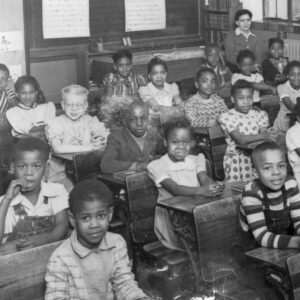May 17 marks 70 years since the Supreme Court unanimously declared that racial segregation in public education was unconstitutional. Brown v. Topeka Board of Education was the most important legal case of the 20th century. The decision seems to have been all but inevitable in the nation’s gradual advance from rigid Jim Crow restrictions to a more just and equitable society.
Jackie Robinson integrated major-league baseball in 1947. South Carolina reluctantly outlawed Democratic White primary elections that year. President Harry Truman ordered military forces to be integrated in 1948. The Supreme Court refused to allow Texas to create a separate law school for Black people in 1950.
Wasn’t the desegregation of public education sure to follow?
Not if South Carolina’s resourceful and savvy governor had his way. James F. “Jimmy” Byrnes would supervise the creation of a formidable defense of segregation that lacked the histrionics and inflammatory language of later Southern governors, including Orval Faubus, Ross Barnett, George Wallace and Lester Maddox.
The legal assault on segregation in public schools began in rural and impoverished Summerton in Clarendon County, South Carolina, in 1950 when Black parents, led by AME minister Joseph A. DeLaine, filed a petition to equalize the public schools in their school district.
Navy veteran Harry Briggs and his wife, Liza, were the first of 55 names on the petition. NAACP legal counsel Thurgood Marshall, assisted by Robert Carter, argued and lost the case of Briggs v. Elliott before a three-judge federal panel in Charleston in 1951.
The Briggs case was appealed to the Supreme Court, consolidated with cases from Kansas, Virginia, Delaware and the District of Columbia, and became inaccurately identified as Brown v. Board. However, the Briggs case was the centerpiece of the Supreme Court’s attention, and it was Gov. Byrnes who organized and directed the defense of segregation.
Byrnes enlisted the support of the nation’s foremost constitutional attorney, John W. Davis, who provided his services pro bono. Davis had an enviable record of arguing and winning more cases before the Supreme Court than any other 20th-century attorney, and he was absolutely committed to segregation.
Not content to rely on Davis’ legal skills, Byrnes turned to political and personal contacts he had developed over three decades of public service in Washington. Byrnes, a loyal Democrat who served in the House and the Senate, was a trusted adviser of Franklin Roosevelt during the New Deal, and was appointed by FDR to the Supreme Court in 1941.
Stepping down from the court in 1942, he directed the Office of Economic Stabilization and then the Office of War Mobilization before serving as secretary of state from 1945 to 1947. He was Time magazine’s “Man of the Year” in 1946.
Elected governor of South Carolina in 1950, Byrnes surprised many people by supporting Republican Dwight Eisenhower’s election in 1952.
The school segregation case was first argued before Chief Justice Fred Vinson and the Supreme Court in 1952. But Vinson, who was inclined to uphold segregation in public schools based on the precedent established by Plessy v. Ferguson in 1896, died unexpectedly in September 1953. Vinson’s untimely death prompted Justice Felix Frankfurter to observe dryly: “This is the first indication I have ever had that there is a God.”
President Eisenhower appointed former California governor Earl Warren as chief justice. Warren would preside when the case was reargued in 1953.
Byrnes was unrelenting. In letters, phone calls and at least one luncheon, the governor appealed to Eisenhower to support states’ rights and not interfere with matters regarding race. Eisenhower listened carefully but was noncommittal.
Undeterred, Byrnes continued to implore the president to withhold federal authority and allow the states to make distinctions between people “provided such distinctions are not arbitrary and unreasonable.” Ike thanked Byrnes but said he had turned the matter over to his attorney general, Herbert Brownell.
Meanwhile, Byrnes turned to his friend and former colleague on the Supreme Court, Frankfurter, and assured the justice that “we are making progress” in providing “equal facilities for White and colored children.” Frankfurter initially seemed persuaded by the governor’s appeal.
Byrnes and Davis were confident that the court would rely on the Plessy precedent and uphold “separate but equal.” It was not to be. Chief Justice Warren announced on May 17, 1954, that separating students by race was unconstitutional.
“We conclude that in the field of public education the doctrine of ‘separate but equal’ has no place. Separate educational facilities are inherently unequal.” Byrnes and Davis were stunned.
Had it not been for Vinson’s fatal heart attack, Byrnes’ determined efforts and his contacts with influential national figures might have succeeded in perpetuating segregation in public education. It’s regrettable that Byrnes, with years of involvement in a broader world, lacked the foresight and wisdom to support desegregation and counsel acceptance of the changes transforming American society.


